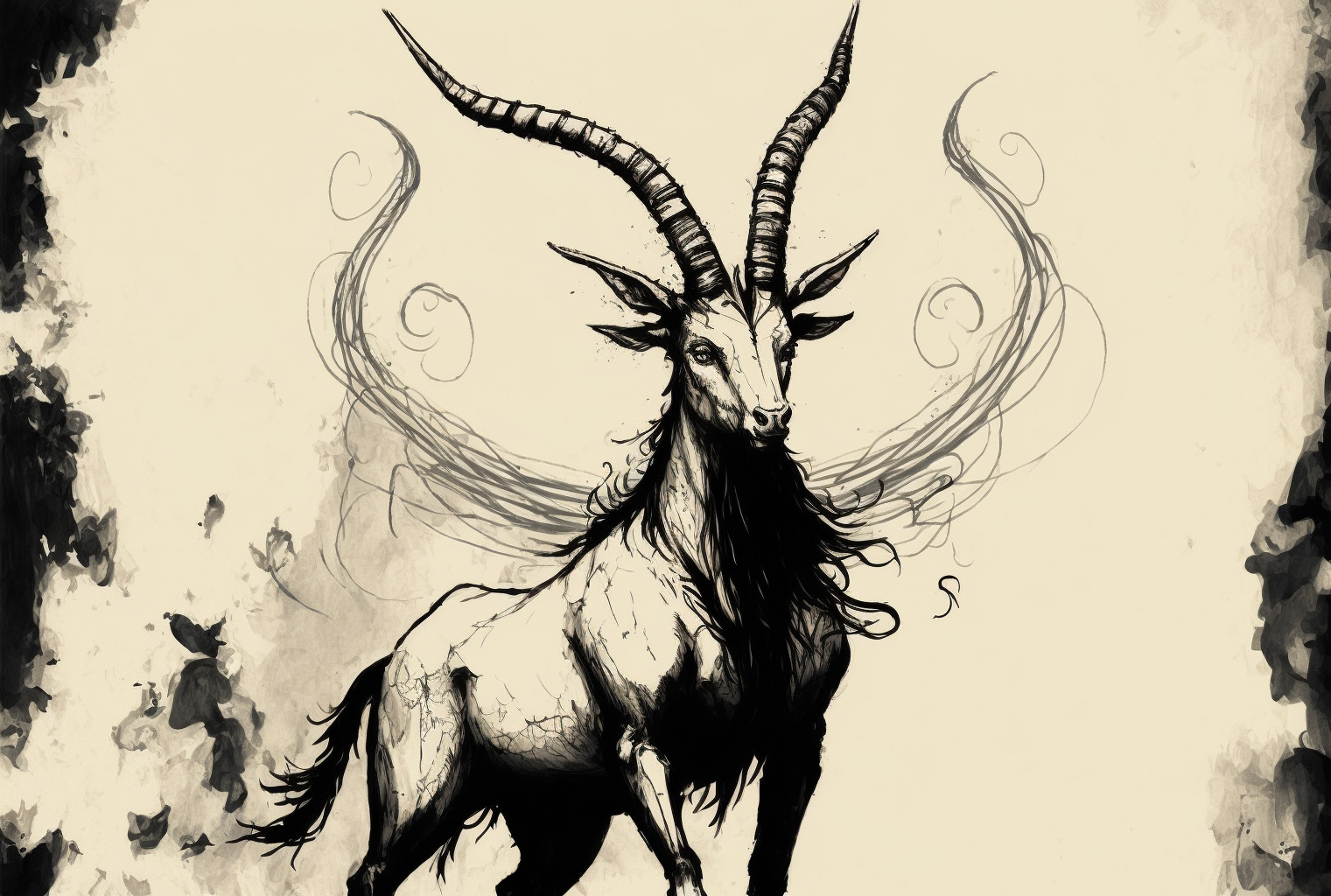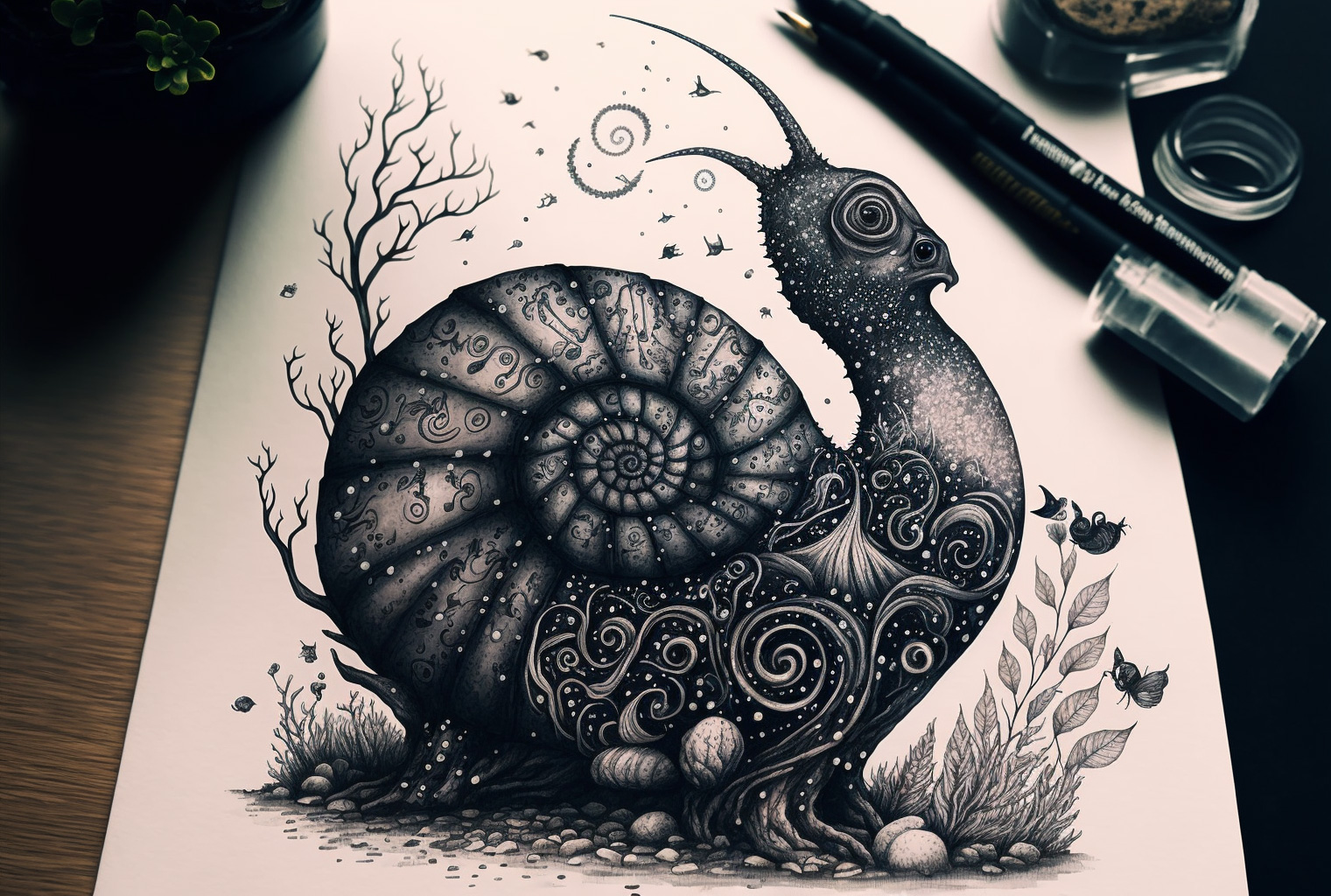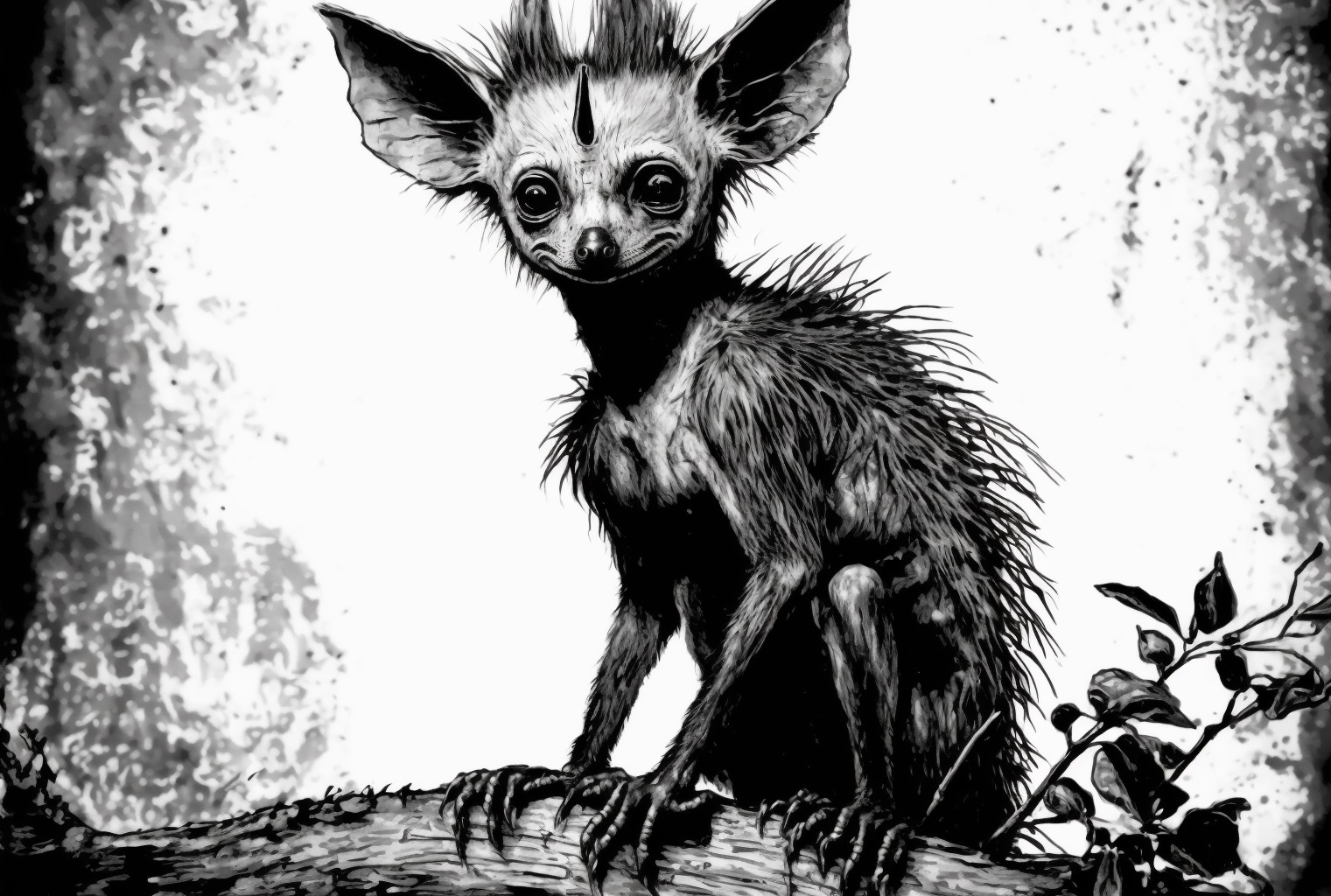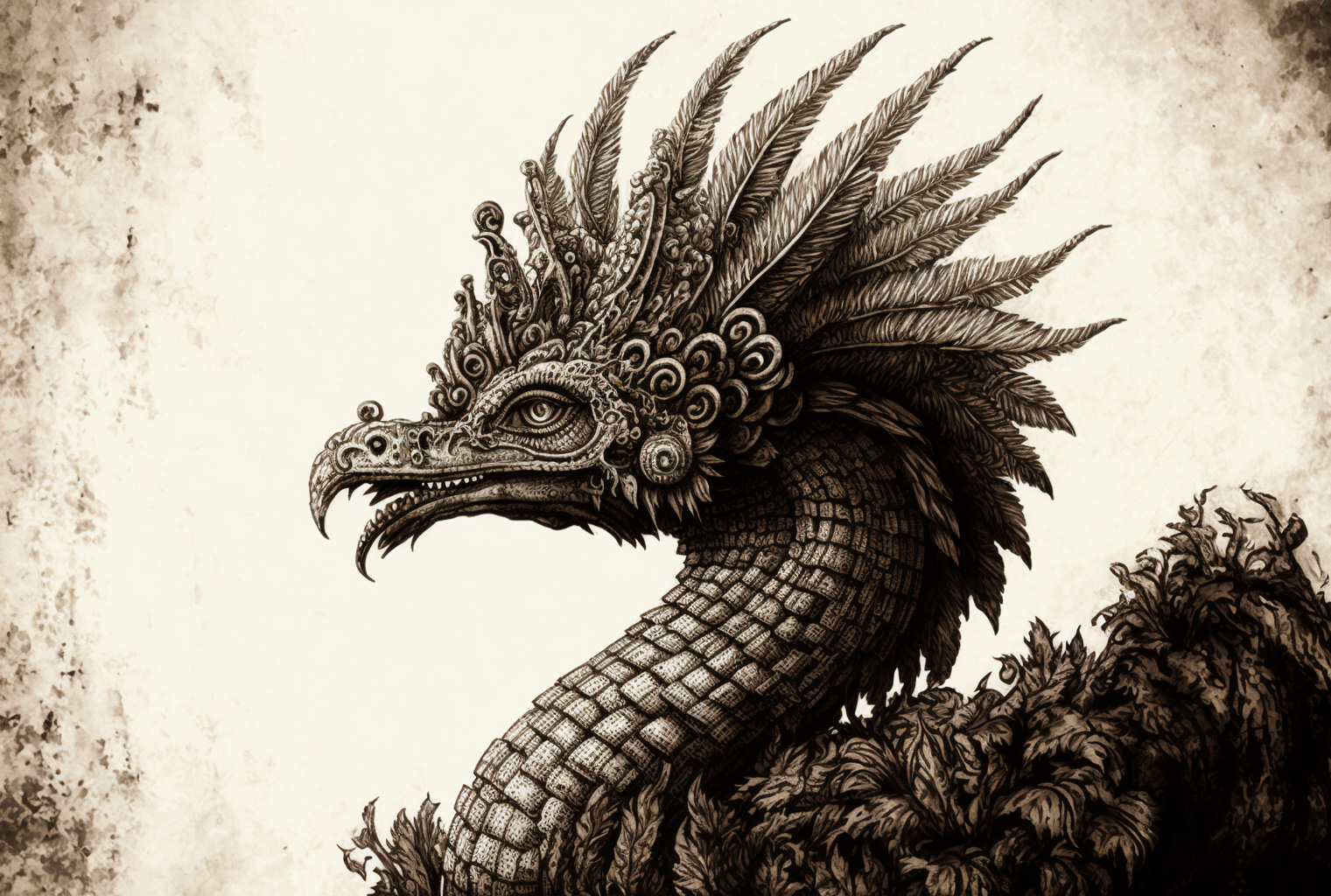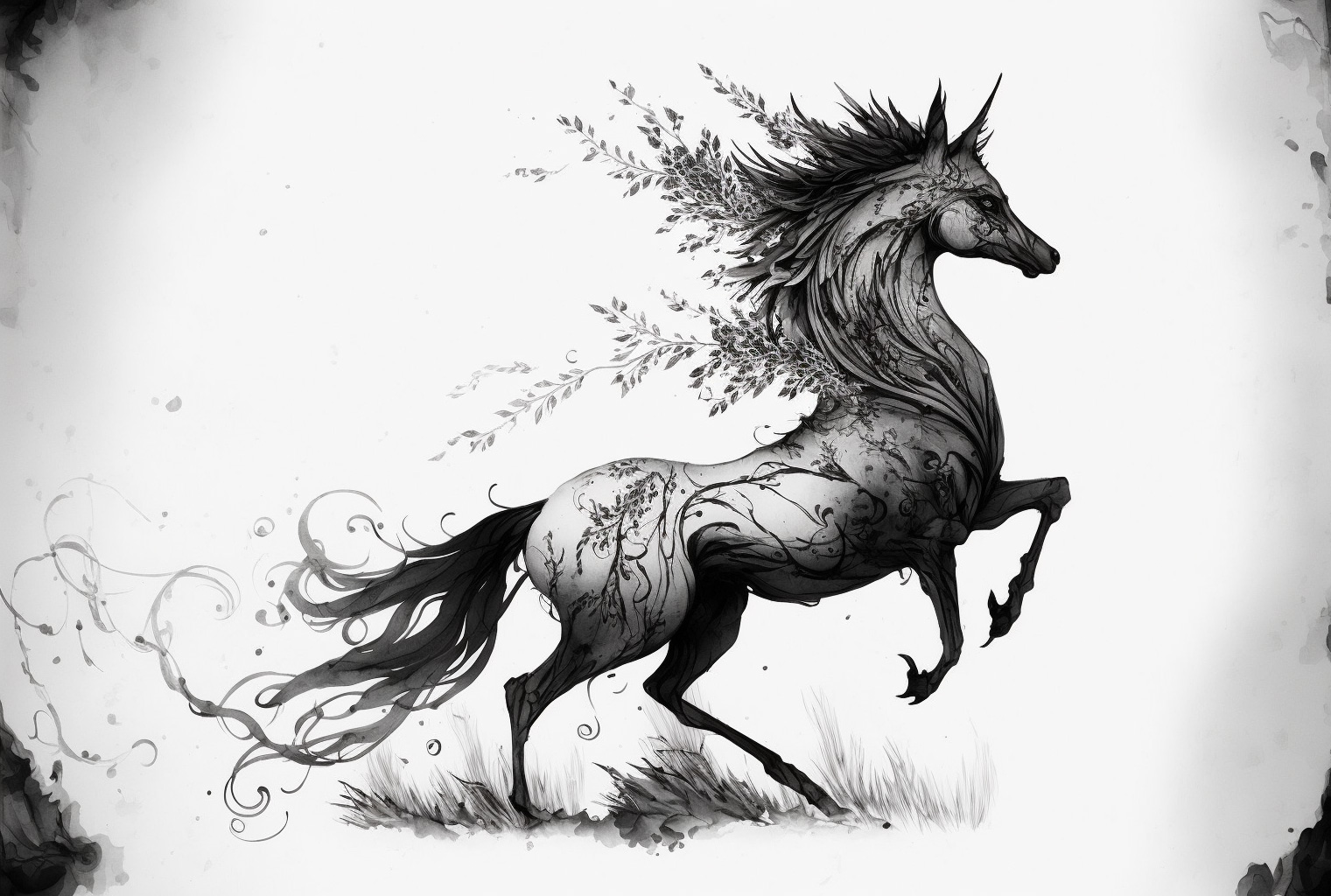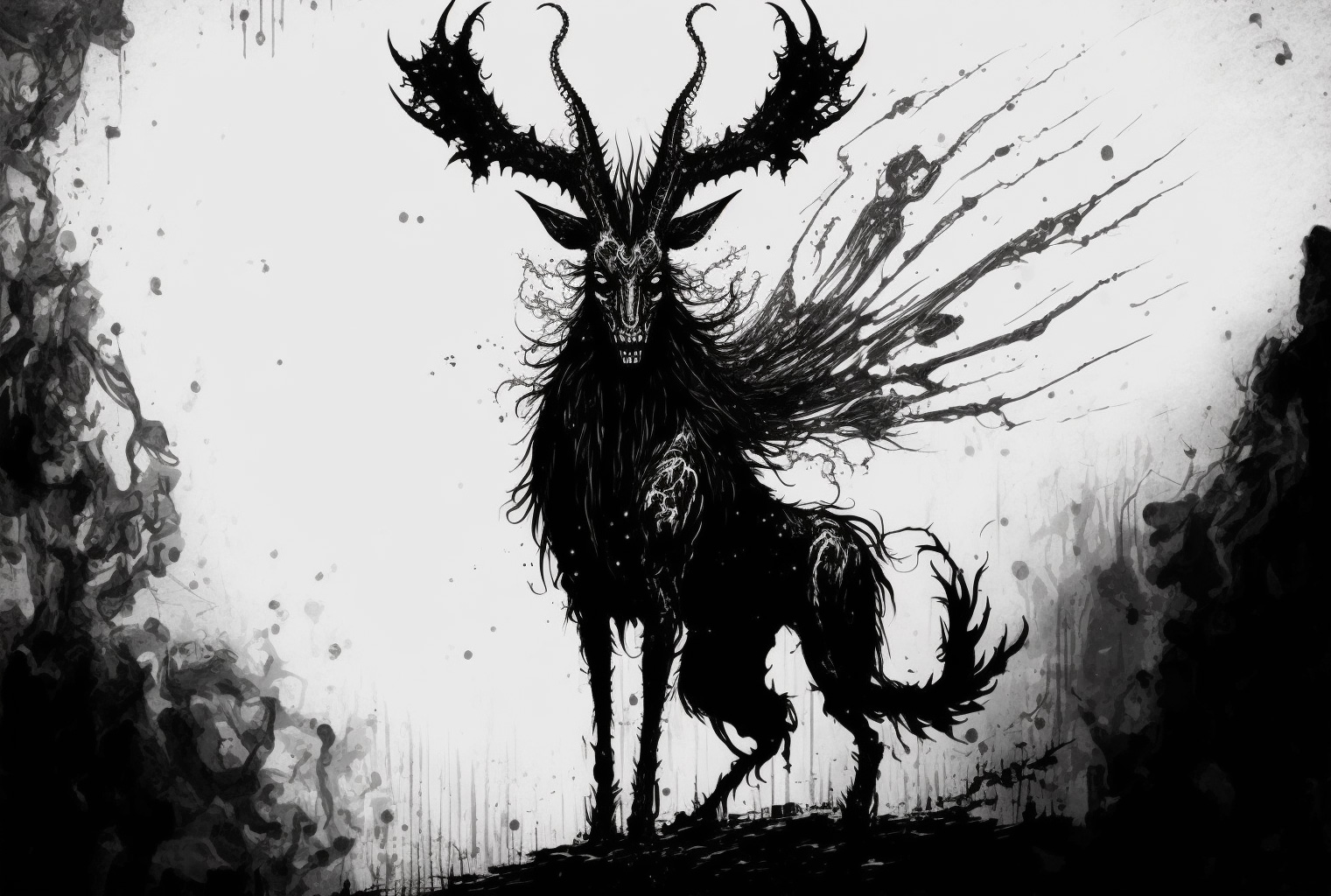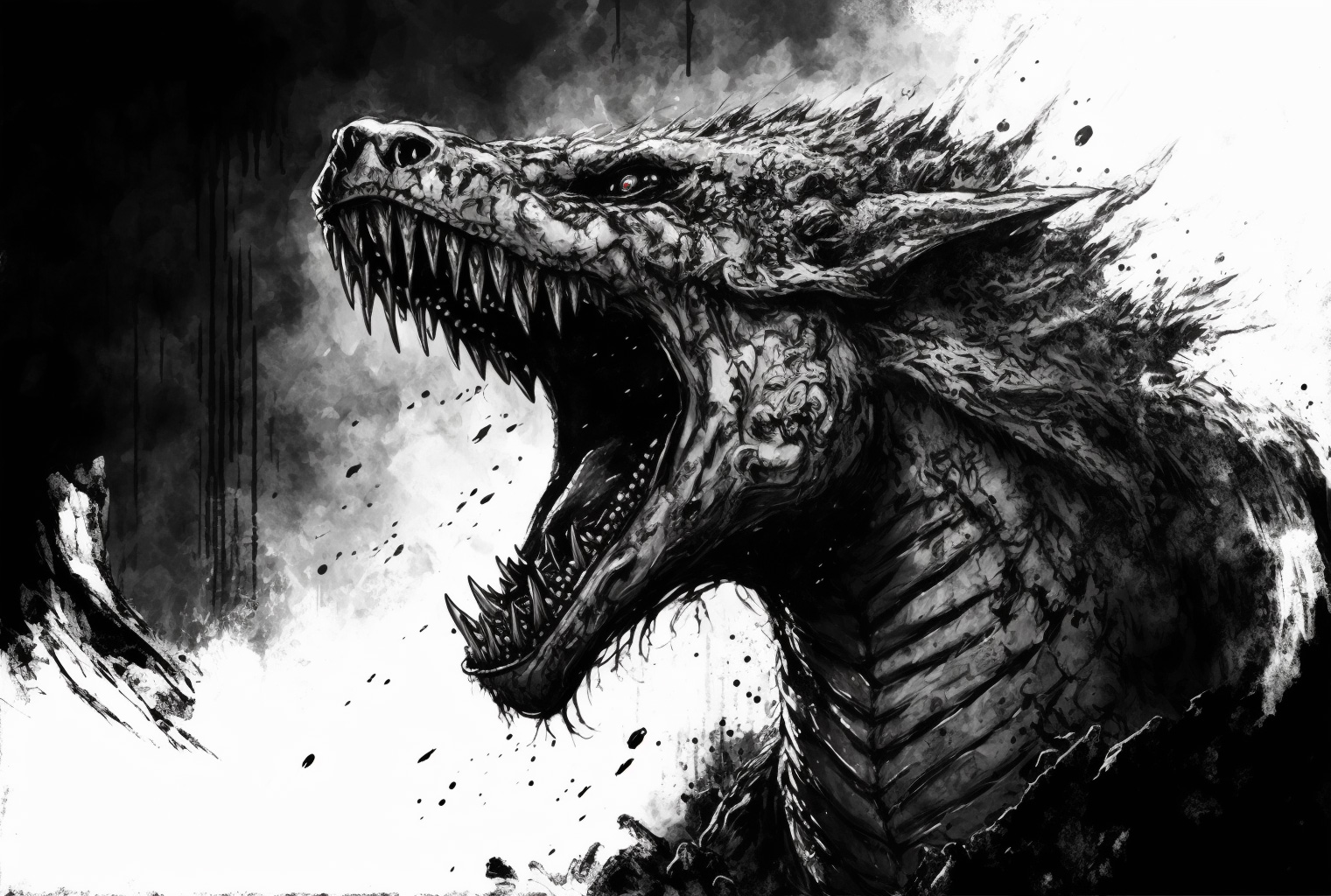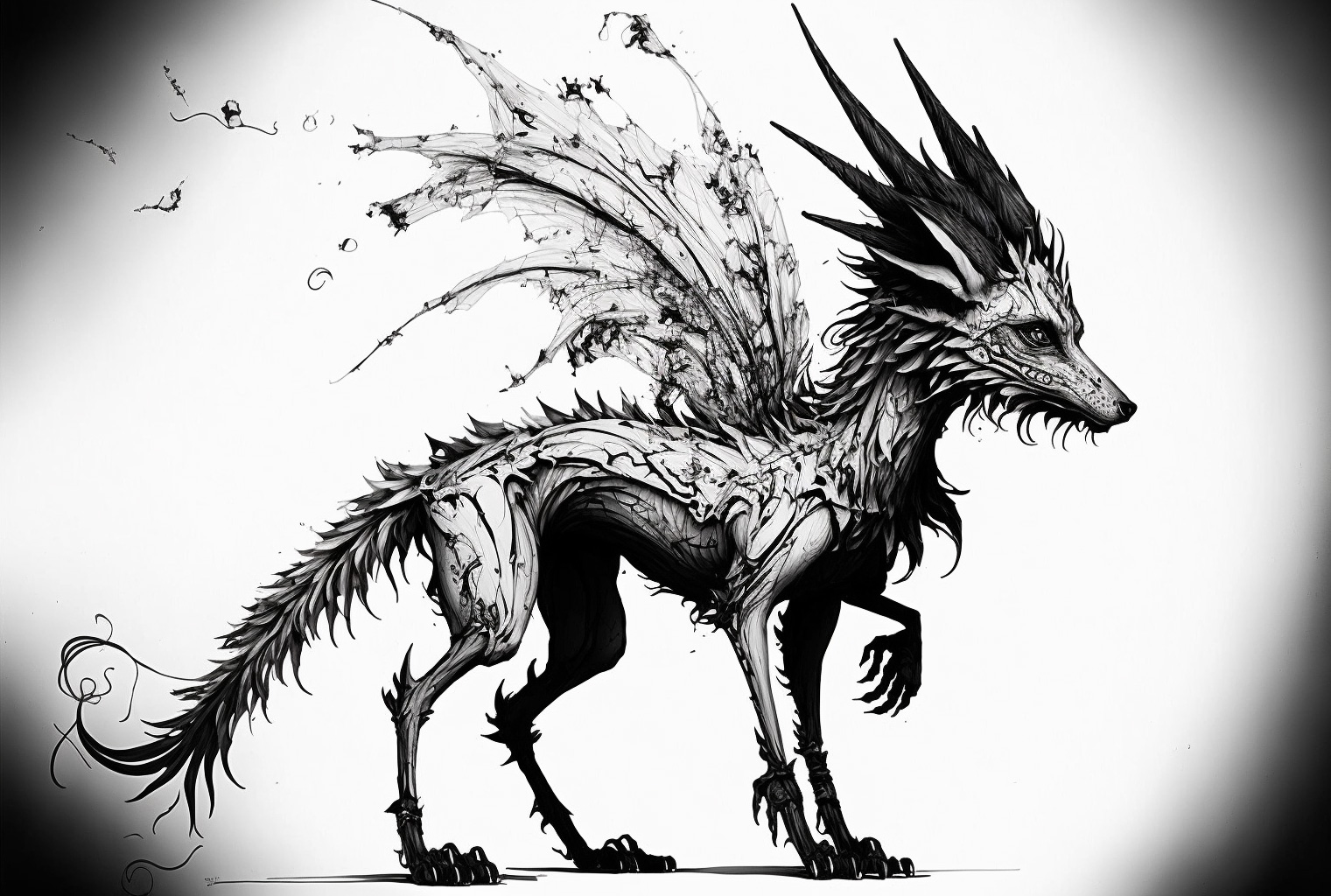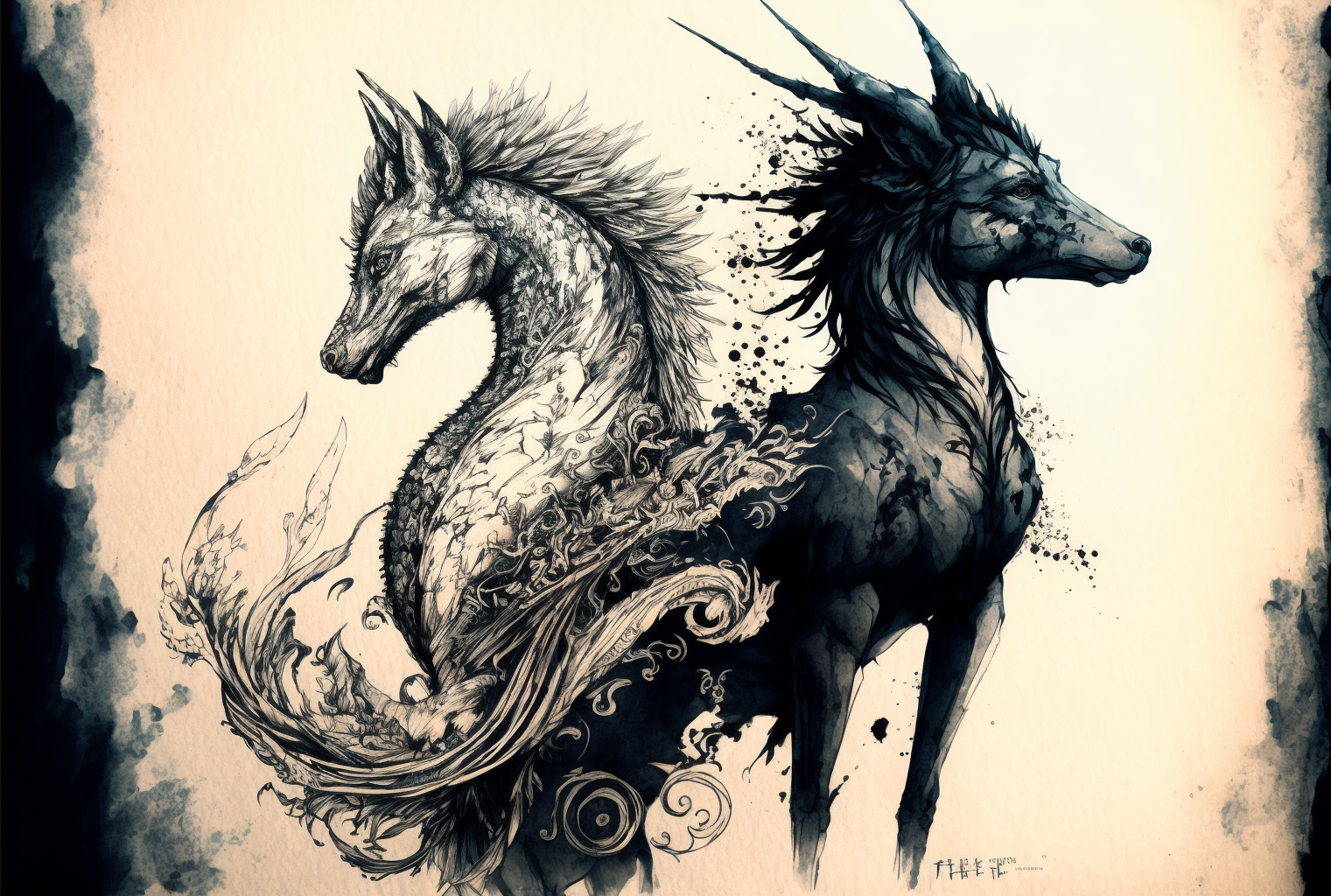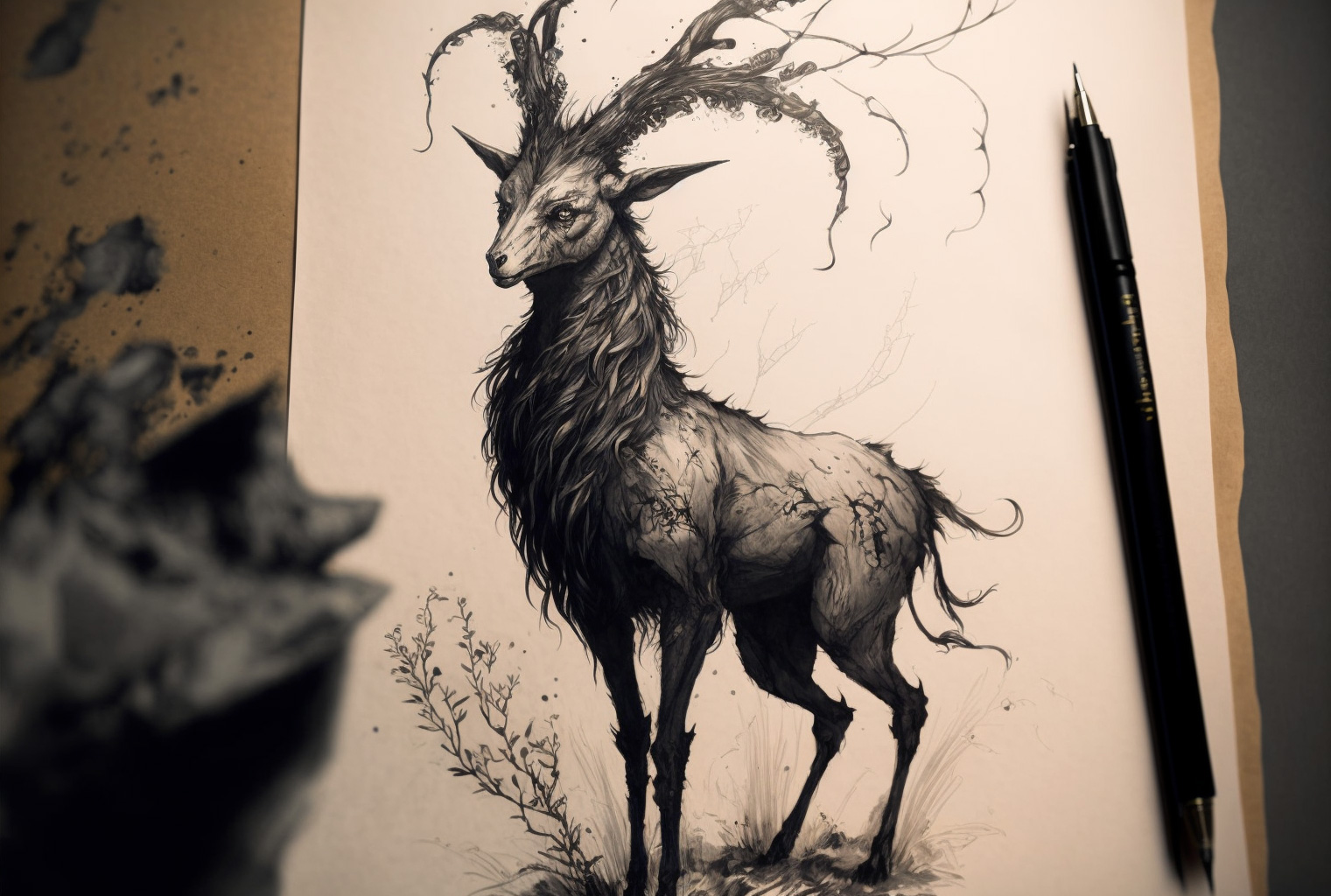Beastuary (Bestiary February 2023)
Click to show the prompt list.

diet: omnivorous (fruit, tubers, fish, eggs)
size: 3' at the withers The hawkmare is a swift, lightly-built creature that roams in loosely-associated herds across windswept plateaus. It is pale in coloration and communicates with shrill, whistling neighs. Known as mercurial due to its unpredictable herding patterns and its fight-or-flight response to threats, it is rarely dangerous unprovoked, but in large numbers may still present a risk to life and limb.
diet: omnivorous scavenger
size: 5' tall Despite having a reputation of savagery and low intelligence, the sandtiger goblin is clever and cunning. They live in nomadic family groups in warm, dry areas and craft basic tools and armor from wood, bone, and leather that they harvest from their prey. These goblins practice ritual cannibalism and have been caught digging up and consuming the corpses of other species' buried dead. They are near-universally disliked and ill-understood.
diet: herbivorous
size: 4' at the withers The star ram, as it is most commonly called, is a plentiful herbivore that dwells in high-altitude deciduous and coniferous forests. They display no obvious marks of fey or arcane influence, despite their doubled pair of ears setting them apart from similar ungulates. These passive grazers are swift over short distances and capable of breathtaking leaps across uncertain, rocky terrain, making them challenging prey for beast and hunter alike.
diet: insectivorous
size: 1' The dreaming snail is an enormous, long-lived snail with an unusually thick and robust spiral shell. The slime it secretes is psychoactive to most mammals on touch and can be deadly if ingested. Excess mucus from these snails is often gently harvested and used in ritual comestibles for religious or arcane experiences. The snails have little regard for other life forms; it is unknown if they experience hallucinogenic effects from their own slime.
diet: herbivorous
size: 2' at the withers The paradision, so named because it is considered a native of some ethereal paradise, is a small and skittish deer-like mammal that lives in subtropical and tropical forests. They are largely solitary, but not hostile to others of their kind unless food is scarce. Paradision "feathers" are actually a strange form of hair, covergently evolved to be similar to avian plumage. Their vivid coloration helps them blend in with bright tropical foliage.
diet: fructivore and insectivore
size: 1' in length These small, harmless lemurs are the focus of superstition in nearly every culture where they live. Widespread across warm-to-temperate deciduous forests, they communicate with ghostly, dissonant hooting calls and high, thin screams. Despite their reputation as bad omens, eave-lurkers are docile, curious, and friendly creatures similar to some monkeys. They are skilled climbers and can occasionally be domesticated and trained.
diet: obligate carnivore
size: 22' in length This cousin-of-dragons has been mythologized as a herald of the rainy season in the warmest parts of the world. Crested with colorful feathers and covered in gem-like scales, the rain-bearer is a migratory creature that rides the changing point between seasons. For its size, the rain-bearer is remarkably unhostile to humanoid life. Many communities leave gifts of fresh livestock and eggs for it as it passes by, resulting in a passive and docile traveling predator.
diet: photosynthesis
size: 4' at the withers The clawbloom dryad is a kind of animal-mimicking plant, animated and mobilized by fey magic. It is curious but shy, all too aware of its status as preferred meal for many creatures and peoples alike. The dryad's woody, fine-haired body harbors a dense, fruity "meat" with tuber-like texture inside. Its scent is luxuriously fragrant, reminiscent of blooming flowers and ripe fruit, which further draws hungry wildlife to its location.
diet: obligate carnivore
size: 8' at the withers The gloom-eater is one of the most common forms that the Hunger of the Fey adopts when it wishes to be ambulatory and active in hunting new prey. It consumes and animates the carcass of a deer, elk, or moose with black ichor and writhing fungus. The resultant monstrosity tirelessly seeks out new sources of flesh, living or dead without preference, ripping them apart with skeletal teeth and liquifying soft tissues with caustic spores.
diet: obligate carnivore
size: 5' tall The clacker is a nightmarish figure to nearly all intelligent peoples. It has been hunted and repulsed from most areas near settlements for its bloody appetite and skulking nature. Unfortunately for the clacker, it is a largely peaceful creature that prefers to hunt small animals, underground fish, and other insectoids. Its unsettling appearance has sealed its reputation as horrific and disturbing, regardless of the truth.
diet: omnivorous
size: 1' at the withers The fairy lynx is a rare, elusive creature that lives in the hearts of coniferous forests and the slopes of tall mountains. Its fey nature has never been proven, but it is the topic of many fairytales nonetheless. Despite its name, the fairy lynx is remarkably mundane in its habitat, its limited socialization with its own kind, and its hunting methods. Only reports of an "eerie" or "supernatural" presence continue to give weight to its mythological status.
diet: obligate carnivorous
size: 4' at the withers The wolf-drake is a hyperterritorial predator that can single-handedly replace an entire wolf pack in a local environment's food chain. It is solitary and prefers to warn off intruders with displays of noise and strength, often breaking small trees or tossing fallen logs. For those who respective the wolf-drake's boundaries, it is a surprisingly peaceful neighbor. It patrols its own territory and hunts within it, rarely leaving even for easy prey like nearby livestock.
diet: omnivorous
size: 3' tall Burdened with many unflattering names, the "redcock" is a large, aggressive cousin to the domestic chicken. It is loud, messy, relentlessly destructive to natural and manmade structures, and unfortunately clever enough to break into livestock pens and coops. The "dirt turkey" is a pest wherever it is found, as well as an invasive species anywhere it can manage to live: usually dry, warm-to-hot areas. It natively hunts small rodents, lizards, and large insects.
diet: unknown
size: 3' tall The green singer may have spawned from a wolf cursed by the fey or a blooming vine over-blessed. Its current form is a limbless, keening canine made of gleaming ivy that moves as responsively as flesh. The green singer is thought to be a distant relative to the vegetable lamb of Tartary, a blood-and-bone animal born of a flowering plant. Unlike the lamb, though, the singer is desperate to escape its prison of root and loam; it constantly writhes, trying to tear itself free.
diet: omnivorous scavenger
size: 1' at the withers One of the few semi-domesticated dryads, the jackpip is a small, heat-loving creature that superficially resembles a coyote. It is responsible for much of the pollination and seed distribution that occurs in desert biomes where it lives. Because of its usefulness in helping flora survive and in feeding upon many pest rodents, most settlements encourage jackpip colonies on the outskirts of their territories.
diet: omnivorous
size: 4-6' at the withers The Anderran drake is one of the most populous draconids, able to live in sparse to dense forests at middling to high altitudes. They are opportunistic scavengers, pack-based hunters, and solitary fishers and foragers; the massive variations in their speciation are due to stationary landraces, migratory groups, and highly-mutile genetics. The intelligence of these drakes is uncertain; they seem exceedingly clever, but whether that wit is corvid or humanoid is unknown.
diet: omnivorous
size: 20' long This rough-scaled "serpent" lives underground in caverns, burrows, and cave networks. Despite its enormous length, its body can flatten and distort in order to squeeze through even tiny gaps in stone. The flat-tail worm is rarely seen and is conflict-averse, preferring to consume dead or decaying flesh or plant matter in the safety of its tunnels. However, it can be a proficient fisher when it comes to cave fishes and salamanders.
diet: omnivorous
size: 3' at the withers The "twin hounds" are less a species and more a pair-bonded role fulfilled by one of the various fey-touched canines. Most often, the twin hounds are tall, lean but powerful sighthounds of opposing colors or patterns, not explicitly arcane but plainly fey-influenced. The twins have been mythologized as omens, fate-bringers, or blessings. They are rarely aggressive when left alone, preferring to stand and observe certain events from a short distance.
diet: omnivorous
size: 5.5' tall The spore-bearer is one of the only fungal lifeforms that is not actively predatory to flesh-and-blood life. It resembles a humanoid dryad (and may have been grown upon the husk of one) and feeds mostly on scavenged carcasses and rotting fruits. It moves slowly and unaggressively, and while it is nearly impossible to truly kill, its lanky limbs are easily broken and scattered. It displays no real intelligence beyond a leisurely search for unliving sustenance.
diet: insectivorous
size: 4" tall The chirper is endemic to nearly every biome, though its exact size, shape, and coloration vary across regions. It is small, surprisingly hardy, and breeds so rapidly that even heavy predation will not eradicate the presence of the colony. Chirper eggs are small and rock-hard, but when soaked in a softening marinade can be baked or broiled as a delicacy. Chirper meat provides an important staple food for many migratory communities.
diet: herbivorous
size: 4' at the withers The omen would be unremarkable if not for the symbiotic flowering moss that grows on, and feeds on, their antler velvet. This moss lives year-round and has usurped the normal process of shedding velvet, so omens are decorated with natural foliage reflective of the season. Beyond this moss, omen are quite mundane. They travel in small herds of same-sex family members, intersecting only during breeding season before parting to bear and rear fawns.
diet: invertebrates
size: up to 10' long The grouper is a poorly-understood fish that could qualify as a school even alone. The female of the species is enormous and territorial, and she lays her eggs on her scales all over her body. The young fish hatch and remain with their mother until large enough to survive alone. Male groupers never grow larger than these minnows, dispersing to fertilize the scale-borne eggs of other adult females. While few creatures would challenge a mother grouper, the young and the males are easily netted and harvested once they stray from her side.
diet: carnivorous
size: up to 12' long The trapjaw is a fish-shaped aquatic plant whose tail bears more resemblence to roots than to fins. It is an ambush predator, anchoring itself with its tail at the bottom of silty rivers and waiting for small fish or reptiles to pass within striking distance. While normally content to lurk at the bottom, in shallow enough bodies of water trapjaws become a distinct threat to passing boats and swimmers. They frequently out-compete alligators.
diet: unknown
size: 5' at the withers The phantom is another fey-influenced canine, kin to the twin hounds but solitary and secretive. Through unknown means, it secretes an inky smoke at will to help obscure itself in dark and tangled forests. It is notoriously soundless. A persistance predator, the phantom will identify its prey, dart in to make a bleeding bite, then trail its target until it weakens through exhaustion and blood loss and eventually collapses.
diet: blood
size: up to 6" long The spiny leech is a resident of ichor-choked bogs, a corrupted larger version of a normal leech. Its uneven legs help propel it along uncertain surfaces, and its hairlike spines are easily detached and left in the craw of any would-be predators. Though the spiny leech's head bears almost reptilian jaws, it still survives on blood and not flesh. If larger lifeforms are not available, it is capable of crushing insects and tiny fishes to suck them dry.
diet: obligate carnivore
size: 6' tall The deathless hunger is kin to the stalking gloom-eater: both are carcasses animated by the Hunger of the Fey, a lethal and predatory fungus. It consumes living and dead flesh with an infectious, caustic, fast-propogating spray of spore-bearing ichor. The humanoid deathless hunger is much rarer than the gloom-eater. This form is indicative that the Hunger requires tool-using limbs in order to access its prey in well-guarded places, like locked homes.
diet: unknown
size: 10' tall The shadow is a mysterious creature whose true form is uncertain. Is it made of swarming insects, or ambulatory foliage, or creeping fungus? Its outline would suggest a strawman-like construction of dried weeds and broken branches--or is that fur? Being large, silent, and monstrous in appearance, the seeking shadow's presence sends all scattering in fear before it. Does it follow them to hunt, to terrify, or for some other reason?

For this month, I wanted to indulge in designing creatures through AI art and spinning flavor text around them. Should you desire to use any of these creatures in your own stories or RPGs, you're more than welcome! They are not unique to any of my own worlds.
01. wings
the mercurial hawkmare
classification: flighted quadrupedal aviandiet: omnivorous (fruit, tubers, fish, eggs)
size: 3' at the withers The hawkmare is a swift, lightly-built creature that roams in loosely-associated herds across windswept plateaus. It is pale in coloration and communicates with shrill, whistling neighs. Known as mercurial due to its unpredictable herding patterns and its fight-or-flight response to threats, it is rarely dangerous unprovoked, but in large numbers may still present a risk to life and limb.
02. stripes
the sandtiger goblin
classification: primitive humanoiddiet: omnivorous scavenger
size: 5' tall Despite having a reputation of savagery and low intelligence, the sandtiger goblin is clever and cunning. They live in nomadic family groups in warm, dry areas and craft basic tools and armor from wood, bone, and leather that they harvest from their prey. These goblins practice ritual cannibalism and have been caught digging up and consuming the corpses of other species' buried dead. They are near-universally disliked and ill-understood.
03. horn
the star-horned fairy ram
classification: pseudomundane ungulatediet: herbivorous
size: 4' at the withers The star ram, as it is most commonly called, is a plentiful herbivore that dwells in high-altitude deciduous and coniferous forests. They display no obvious marks of fey or arcane influence, despite their doubled pair of ears setting them apart from similar ungulates. These passive grazers are swift over short distances and capable of breathtaking leaps across uncertain, rocky terrain, making them challenging prey for beast and hunter alike.
04. shell
the dreaming snail
classification: giant fey-touched gastropoddiet: insectivorous
size: 1' The dreaming snail is an enormous, long-lived snail with an unusually thick and robust spiral shell. The slime it secretes is psychoactive to most mammals on touch and can be deadly if ingested. Excess mucus from these snails is often gently harvested and used in ritual comestibles for religious or arcane experiences. The snails have little regard for other life forms; it is unknown if they experience hallucinogenic effects from their own slime.
05. colorful
the fleet-feathered paradision
classification: fey-touched cervinediet: herbivorous
size: 2' at the withers The paradision, so named because it is considered a native of some ethereal paradise, is a small and skittish deer-like mammal that lives in subtropical and tropical forests. They are largely solitary, but not hostile to others of their kind unless food is scarce. Paradision "feathers" are actually a strange form of hair, covergently evolved to be similar to avian plumage. Their vivid coloration helps them blend in with bright tropical foliage.
06. nocturnal
the hooting eave-lurker
classification: nocturnal arboreal primatediet: fructivore and insectivore
size: 1' in length These small, harmless lemurs are the focus of superstition in nearly every culture where they live. Widespread across warm-to-temperate deciduous forests, they communicate with ghostly, dissonant hooting calls and high, thin screams. Despite their reputation as bad omens, eave-lurkers are docile, curious, and friendly creatures similar to some monkeys. They are skilled climbers and can occasionally be domesticated and trained.
07. mythical
the sacred rain-bearer
classification: primitive avian (feathered saurian)diet: obligate carnivore
size: 22' in length This cousin-of-dragons has been mythologized as a herald of the rainy season in the warmest parts of the world. Crested with colorful feathers and covered in gem-like scales, the rain-bearer is a migratory creature that rides the changing point between seasons. For its size, the rain-bearer is remarkably unhostile to humanoid life. Many communities leave gifts of fresh livestock and eggs for it as it passes by, resulting in a passive and docile traveling predator.
08. prey
the clawbloom dryad
classification: fey unguliforme (motile tracheophyte)diet: photosynthesis
size: 4' at the withers The clawbloom dryad is a kind of animal-mimicking plant, animated and mobilized by fey magic. It is curious but shy, all too aware of its status as preferred meal for many creatures and peoples alike. The dryad's woody, fine-haired body harbors a dense, fruity "meat" with tuber-like texture inside. Its scent is luxuriously fragrant, reminiscent of blooming flowers and ripe fruit, which further draws hungry wildlife to its location.
09. monstrous
the stalking gloom-eater
classification: fey unguliforme (skeletal cordyceps)diet: obligate carnivore
size: 8' at the withers The gloom-eater is one of the most common forms that the Hunger of the Fey adopts when it wishes to be ambulatory and active in hunting new prey. It consumes and animates the carcass of a deer, elk, or moose with black ichor and writhing fungus. The resultant monstrosity tirelessly seeks out new sources of flesh, living or dead without preference, ripping them apart with skeletal teeth and liquifying soft tissues with caustic spores.
10. danger
the scurrying clicky-clacker
classification: semi-bipedal arthropoddiet: obligate carnivore
size: 5' tall The clacker is a nightmarish figure to nearly all intelligent peoples. It has been hunted and repulsed from most areas near settlements for its bloody appetite and skulking nature. Unfortunately for the clacker, it is a largely peaceful creature that prefers to hunt small animals, underground fish, and other insectoids. Its unsettling appearance has sealed its reputation as horrific and disturbing, regardless of the truth.
11. purr
the fairy lynx
classification: pseudomundane feliformediet: omnivorous
size: 1' at the withers The fairy lynx is a rare, elusive creature that lives in the hearts of coniferous forests and the slopes of tall mountains. Its fey nature has never been proven, but it is the topic of many fairytales nonetheless. Despite its name, the fairy lynx is remarkably mundane in its habitat, its limited socialization with its own kind, and its hunting methods. Only reports of an "eerie" or "supernatural" presence continue to give weight to its mythological status.
12. roar
the baneful wolf-drake
classification: predatory synapsiddiet: obligate carnivorous
size: 4' at the withers The wolf-drake is a hyperterritorial predator that can single-handedly replace an entire wolf pack in a local environment's food chain. It is solitary and prefers to warn off intruders with displays of noise and strength, often breaking small trees or tossing fallen logs. For those who respective the wolf-drake's boundaries, it is a surprisingly peaceful neighbor. It patrols its own territory and hunts within it, rarely leaving even for easy prey like nearby livestock.
13. shriek
the rusty canyon cockerel
classification: flightless aviandiet: omnivorous
size: 3' tall Burdened with many unflattering names, the "redcock" is a large, aggressive cousin to the domestic chicken. It is loud, messy, relentlessly destructive to natural and manmade structures, and unfortunately clever enough to break into livestock pens and coops. The "dirt turkey" is a pest wherever it is found, as well as an invasive species anywhere it can manage to live: usually dry, warm-to-hot areas. It natively hunts small rodents, lizards, and large insects.
14. howl
the green singer of tartary
classification: fey caniforme (sessile cornales)diet: unknown
size: 3' tall The green singer may have spawned from a wolf cursed by the fey or a blooming vine over-blessed. Its current form is a limbless, keening canine made of gleaming ivy that moves as responsively as flesh. The green singer is thought to be a distant relative to the vegetable lamb of Tartary, a blood-and-bone animal born of a flowering plant. Unlike the lamb, though, the singer is desperate to escape its prison of root and loam; it constantly writhes, trying to tear itself free.
15. tamed
the sagebrush jackpip
classification: miniature fey caniforme (motile asterid)diet: omnivorous scavenger
size: 1' at the withers One of the few semi-domesticated dryads, the jackpip is a small, heat-loving creature that superficially resembles a coyote. It is responsible for much of the pollination and seed distribution that occurs in desert biomes where it lives. Because of its usefulness in helping flora survive and in feeding upon many pest rodents, most settlements encourage jackpip colonies on the outskirts of their territories.
16. pack
the variegated anderran drake
classification: warm-blooded dragiforme theropsiddiet: omnivorous
size: 4-6' at the withers The Anderran drake is one of the most populous draconids, able to live in sparse to dense forests at middling to high altitudes. They are opportunistic scavengers, pack-based hunters, and solitary fishers and foragers; the massive variations in their speciation are due to stationary landraces, migratory groups, and highly-mutile genetics. The intelligence of these drakes is uncertain; they seem exceedingly clever, but whether that wit is corvid or humanoid is unknown.
17. burrow
the chthonic flat-tail worm
classification: serpentiforme rouphozooiddiet: omnivorous
size: 20' long This rough-scaled "serpent" lives underground in caverns, burrows, and cave networks. Despite its enormous length, its body can flatten and distort in order to squeeze through even tiny gaps in stone. The flat-tail worm is rarely seen and is conflict-averse, preferring to consume dead or decaying flesh or plant matter in the safety of its tunnels. However, it can be a proficient fisher when it comes to cave fishes and salamanders.
18. bond
the twin hounds of the solstice
classification: fey-touched caniddiet: omnivorous
size: 3' at the withers The "twin hounds" are less a species and more a pair-bonded role fulfilled by one of the various fey-touched canines. Most often, the twin hounds are tall, lean but powerful sighthounds of opposing colors or patterns, not explicitly arcane but plainly fey-influenced. The twins have been mythologized as omens, fate-bringers, or blessings. They are rarely aggressive when left alone, preferring to stand and observe certain events from a short distance.
19. stinky
the pungent spore-bearer
classification: fey humanoid (motile ascomycotid)diet: omnivorous
size: 5.5' tall The spore-bearer is one of the only fungal lifeforms that is not actively predatory to flesh-and-blood life. It resembles a humanoid dryad (and may have been grown upon the husk of one) and feeds mostly on scavenged carcasses and rotting fruits. It moves slowly and unaggressively, and while it is nearly impossible to truly kill, its lanky limbs are easily broken and scattered. It displays no real intelligence beyond a leisurely search for unliving sustenance.
20. gentle
the meadowfield chirper
classification: flightless burrowing aviandiet: insectivorous
size: 4" tall The chirper is endemic to nearly every biome, though its exact size, shape, and coloration vary across regions. It is small, surprisingly hardy, and breeds so rapidly that even heavy predation will not eradicate the presence of the colony. Chirper eggs are small and rock-hard, but when soaked in a softening marinade can be baked or broiled as a delicacy. Chirper meat provides an important staple food for many migratory communities.
21. messenger
the bough-crowned omen
classification: pseudomundane ungulatediet: herbivorous
size: 4' at the withers The omen would be unremarkable if not for the symbiotic flowering moss that grows on, and feeds on, their antler velvet. This moss lives year-round and has usurped the normal process of shedding velvet, so omens are decorated with natural foliage reflective of the season. Beyond this moss, omen are quite mundane. They travel in small herds of same-sex family members, intersecting only during breeding season before parting to bear and rear fawns.
22. food
the minnow-scaled grouper
classification: "fish"diet: invertebrates
size: up to 10' long The grouper is a poorly-understood fish that could qualify as a school even alone. The female of the species is enormous and territorial, and she lays her eggs on her scales all over her body. The young fish hatch and remain with their mother until large enough to survive alone. Male groupers never grow larger than these minnows, dispersing to fertilize the scale-borne eggs of other adult females. While few creatures would challenge a mother grouper, the young and the males are easily netted and harvested once they stray from her side.
23. vicious
the river-bottom trapjaw
classification: fey esoxiforme (motile aquatic cyperoid)diet: carnivorous
size: up to 12' long The trapjaw is a fish-shaped aquatic plant whose tail bears more resemblence to roots than to fins. It is an ambush predator, anchoring itself with its tail at the bottom of silty rivers and waiting for small fish or reptiles to pass within striking distance. While normally content to lurk at the bottom, in shallow enough bodies of water trapjaws become a distinct threat to passing boats and swimmers. They frequently out-compete alligators.
24. silent
the inky phantom
classification: fey-touched caniformediet: unknown
size: 5' at the withers The phantom is another fey-influenced canine, kin to the twin hounds but solitary and secretive. Through unknown means, it secretes an inky smoke at will to help obscure itself in dark and tangled forests. It is notoriously soundless. A persistance predator, the phantom will identify its prey, dart in to make a bleeding bite, then trail its target until it weakens through exhaustion and blood loss and eventually collapses.
25. parasite
the black spined leech
classification: multipedal hirudinoiddiet: blood
size: up to 6" long The spiny leech is a resident of ichor-choked bogs, a corrupted larger version of a normal leech. Its uneven legs help propel it along uncertain surfaces, and its hairlike spines are easily detached and left in the craw of any would-be predators. Though the spiny leech's head bears almost reptilian jaws, it still survives on blood and not flesh. If larger lifeforms are not available, it is capable of crushing insects and tiny fishes to suck them dry.
26. predator
the deathless hunger
classification: fey humanoid (motile cordyceps)diet: obligate carnivore
size: 6' tall The deathless hunger is kin to the stalking gloom-eater: both are carcasses animated by the Hunger of the Fey, a lethal and predatory fungus. It consumes living and dead flesh with an infectious, caustic, fast-propogating spray of spore-bearing ichor. The humanoid deathless hunger is much rarer than the gloom-eater. This form is indicative that the Hunger requires tool-using limbs in order to access its prey in well-guarded places, like locked homes.
27. stalk
the seeking shadow
classification: fey humanoid (specificity unknown)diet: unknown
size: 10' tall The shadow is a mysterious creature whose true form is uncertain. Is it made of swarming insects, or ambulatory foliage, or creeping fungus? Its outline would suggest a strawman-like construction of dried weeds and broken branches--or is that fur? Being large, silent, and monstrous in appearance, the seeking shadow's presence sends all scattering in fear before it. Does it follow them to hunt, to terrify, or for some other reason?




